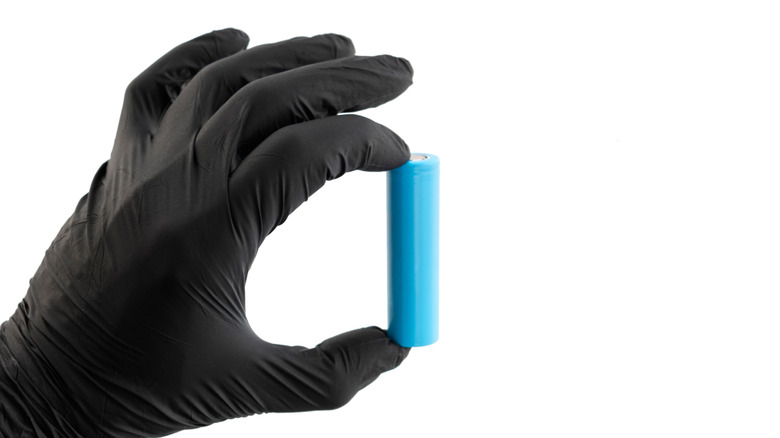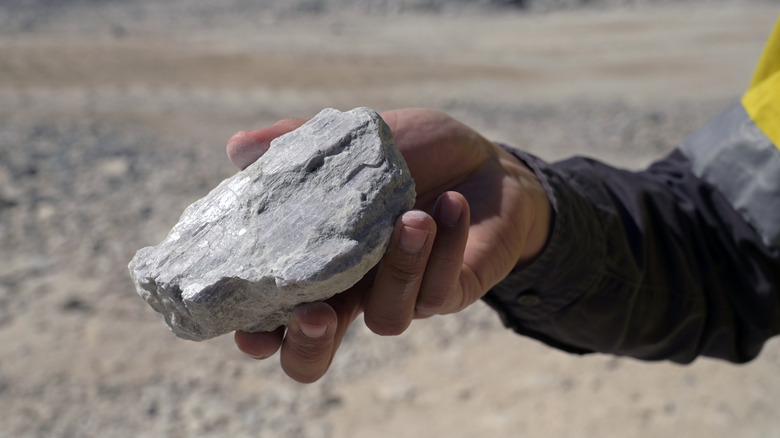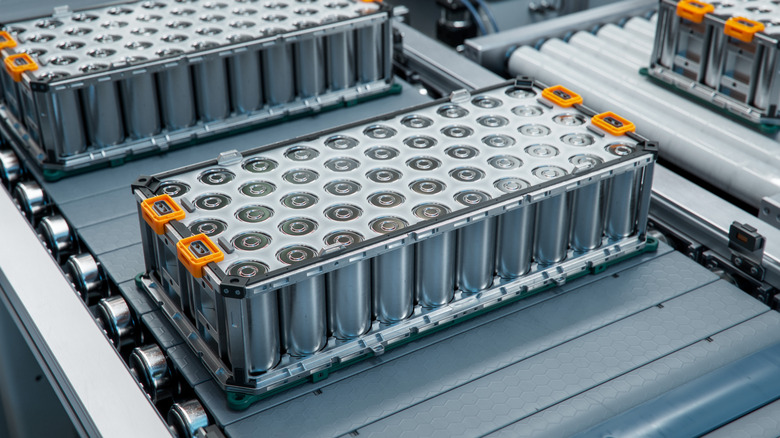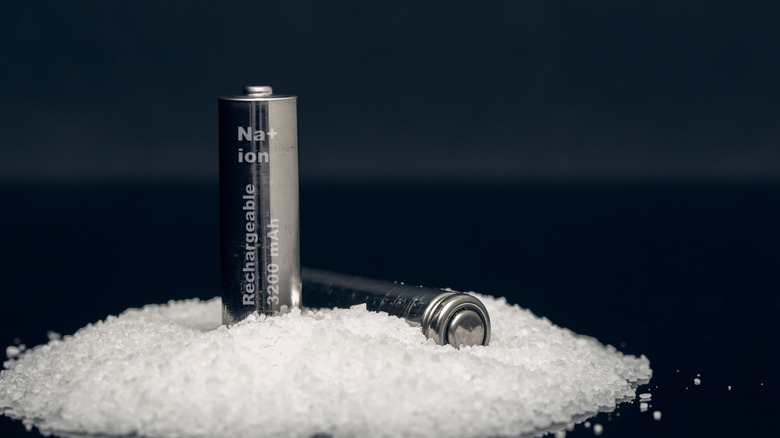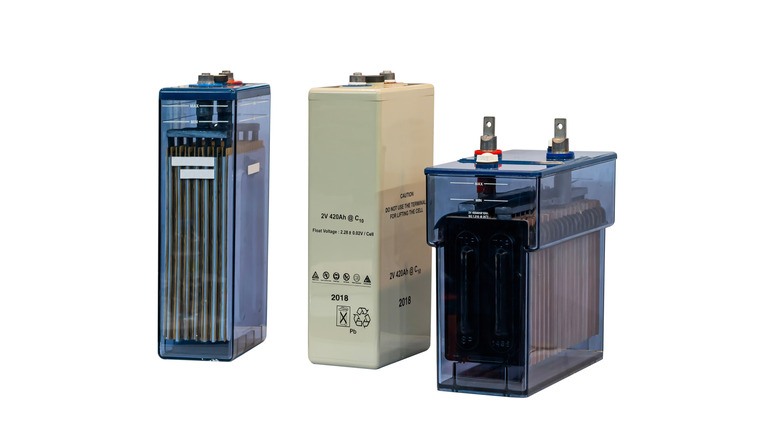What Happens If The World Runs Out Of Lithium?
We may receive a commission on purchases made from links.
When many of us hear the word "lithium," we immediately think about batteries. Indeed, lithium-ion batteries are the most common form of energy storage, and you can find them just about everywhere. The soft alkali metal is present in almost all rechargeable batteries, including those in smartphones, wireless earbuds, smartwatches, and electric vehicles, and it's even in your run-of-the-mill disposable batteries.
For instance, household names like Energizer offer AA batteries primarily made of lithium. Such disposable batteries are usually tossed into the garbage, and from there they eventually end up in a landfill. Even rechargeable batteries have a shelf life, so they too are often thrown away. In both cases, the lithium within those batteries, once discarded, isn't reused. So, with so much lithium being thrown away and never used again, it raises the question: Are we at risk of running out? If we did run out of lithium, what would happen?
These are important questions, since lithium is a finite resource. Worse yet, the extraction of lithium largely occurs in developing countries, where environmental and ethical concerns are largely overlooked. In fact, supply chain disruptions are the more likely candidate for a sudden loss of lithium, while the risk of running out is surprisingly low. The future is uncertain for the land and people that supply the world with lithium, but according to geological surveys, the Earth's crust contains an abundance of the stuff, it's just a question of extraction.
Where lithium comes from
The risk to the global lithium supply depends on the countries that produce it, not the amount of reserves in the ground. The U.S. Geological Survey has described the global reserves as "relatively abundant," and scientists point out that technologies keep getting better at extracting it. Recent estimates place "feasibly extractable" lithium reserves at around 24 million tons, a number that is expected to go up as technologies improve. A more probable risk to lithium supplies comes from the suppliers themselves. For example, the world produced nearly 265,000 tons of lithium in 2024, but just six countries — Argentina, Australia, Brazil, Chile, China, and Zimbabwe — were the source of nearly 40% of that total.
While much of the world's lithium comes from a handful of countries, the companies that actually profit off of the metal's extraction aren't always nationals. Many of the companies that take advantage of lithium extraction operate across borders. One of the biggest extractors is La Sociedad Química y Minera de Chile. It's a company that dominates lithium extraction in Chile, yet it also has huge claims in Australia. Another big player is the U.S.-based company Albemarle, which has claims in the U.S., Chile, and Australia. There are also Canadian companies with mines in Chile and Chinese companies with mines in Australia.
The point is, the biggest lithium mining companies in the world operate in different countries. So while the global supply of lithium may not be at risk of running out, the supply chains aren't so secure. All it takes is one country to nationalize their lithium mines (as Chile planned to do in 2023), and the supply chain will start to shake.
Without lithium, we'd run out of batteries
If the global supply of lithium were to ever run dry, the battery industry would be in crisis. Lithium-ion batteries degrade over time, with things like electrolyte oxidation and repeated recharging diminishing a lithium battery's capacity. Add to that the damage incurred from simple wear and tear, and most lithium batteries will eventually need replacing. In fact, 95% of the lithium in batteries doesn't get recycled. Other parts of batteries may be reused, but lithium is exceedingly hard to recycle and typically ends up in the trash.
The EV industry would be hit especially hard, since almost every EV depends on lithium-ion batteries, and those batteries have a shelf life. Without fresh lithium to replace spent batteries, our optimistic predictions for the EV industry would crumble. The EVs already in operation would eventually roll to a stop, and new EV models couldn't be built.
Beyond electric vehicles, lithium batteries are found in a vast range of electronic gadgets including wireless earbuds, toys, power tools, and just about any other device with a rechargeable battery. Disposable batteries are also largely made out of lithium, and as we all know, those get thrown out every time a television remote dies. Add to that the massive energy storage facilities that store the electricity generated by renewables like hydroelectric and wind turbines, and the lack of lithium would become a societal crisis.
Yet the practice of replacing spent lithium batteries with new ones may actually hold the key to the problem. Rather than having to replace the entire design of the lithium-ion battery, scientists would most likely seek to replace just the lithium part. In other words, if you could find an alternative chemical to take the place of lithium, we wouldn't have to give up our precious EVs.
Sodium and the hunt for lithium alternatives
If the world were to run out of lithium today, we would scramble to find alternatives for our energy storage. Fortunately, engineers are working on it now, and one promising avenue leads us to a familiar element: sodium. Scientists exploring energy storage alternatives propose replacing lithium-ion batteries with sodium-ion batteries. The best part about sodium is it's cheap and abundant. In fact, sodium is nearly 1,200 times more abundant compared to lithium, and extracting it is also easier. After all, sodium is all around us in the oceans, the ground, and in our salt shakers.
Unfortunately for EV owners, sodium-ion batteries just can't store as much energy in as small of a volume as their lithium-based cousins. Sodium-ion batteries' maximum energy density falls around 160 Wh/kg (watt-hour per kilogram), while lithium-ion batteries can store as much as 220 Wh/kg. As a result, a sodium-ion battery would need to be nearly 30% larger to replace a lithium-ion battery of the same capacity. In EVs where every cubic millimeter counts and every extra gram of weight matters, that 30% difference presents a big challenge. Another weakness of sodium-ion batteries is how fast they degrade. Chemical batteries will eventually go flat, so you can't expect to recharge them forever. A sodium-ion battery can typically provide around 5,000 to 6,000 charging cycles before needing to be replaced. A lithium-ion battery, on the other hand, can deliver nearly double that.
Even though jumbo sodium-ion batteries will need more engineering to be a feasible replacement for the lithium-ion batteries in EVs, they're still a viable solution for large-scale energy storage systems where space isn't a problem. One encouraging example of this is the BESS project in China, which uses lithium-ion batteries to store a whopping 40 MWh of electricity.
Potential alternatives to lithium
Sodium-ion batteries seem to be the most promising replacement for lithium-ion batteries, but there are numerous alternative proposals out there. Those proposals include the feasible, like solid-state energy storage, as well as the pie-in-the-sky ideas, like batteries made out of sea water or glass. The liquid-battery concept suggests a future in which you could drive your EV right up to a charge station, like a gas station, and pump freshly-charged liquid into your car. Such liquid batteries could use any kind of non-lithium electrolytes, so the concept tackles the drawback of lithium-alternatives' low charge-cycle lifespans.
Solid-state batteries go in the opposite direction. Unlike lithium-ion batteries, they have no liquid parts. If you've ever had to replace your car battery, you might've heard something sloshing around inside. That's the liquid electrolyte mixture that stores electrical charge. Almost all the batteries in our lives use liquid to suspend ions, or electrolytes, and almost all those electrolyte solutions use lithium. In a solid-state battery, however, the electrolytes don't need an aqueous liquid to store charge. Solid electrolytes can be made of various materials, the most popular being inorganic sulfides, oxides, and polymers.
One curious solid electrolyte may be able to be made out of glass. It's a concept developed by John Goodenough, who won a Nobel Prize in 2019 for his work on the very thing we're trying to replace: lithium-ion batteries. Now, Goodenough has proposed ions suspended in glass could serve as solid electrolytes. The glass battery is still in development, but such an eco-friendly design is certainly promising. Unfortunately, while solid-state batteries do work, scientists haven't discovered the ideal solid electrolyte nor have engineers figured out a practical way to scale up production to replace lithium-ion batteries. Only time will tell.
